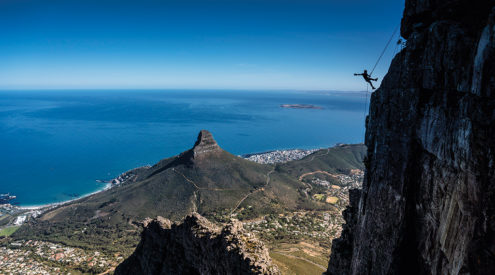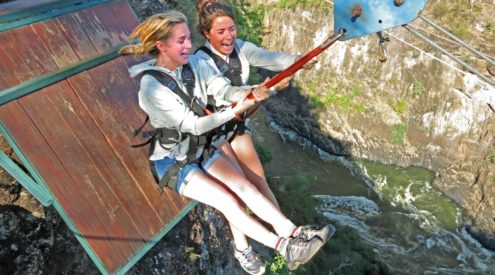
Welcome Lishivha was nicknamed ‘Lion Bait’ for constantly stepping out of line to take pictures, like this one.
Duration 3–4 days
Type Guided
Level Reasonably Easy
We’re walking through the bush in single file. In front, rifle in hand, is game ranger Gert Esterhuizen. He keeps an eye out for interesting sights worth exploring and possible dangers that might be lurking ahead. Bradley is at the back, looking out for anything we might have missed.
The only reason I’m feeling safe is because of Gert’s rifle. A part of me feels guilty for this thought because, before we left, one of the other hikers (who is now walking in front of me) said that if it came down to it, they should rather preserve the animal’s life over hers. A noble thought, but I don’t want to end up as a meal. Upon arrival at Mthimkhulu yesterday, we started by signing our lives away. As we filled in the indemnity forms, guide Bradley Frohlich told us about what to do if an animal – say a lion, elephant or buffalo – charged us. We’d be in the wild. On foot. It’s nerve-wracking and exciting to be flirting with danger like this.
‘We watch from a distance as Stompie shuffles shyly around the trees’
Mthimkhulu is a 7 500-hectare private reserve that shares a 42-kilometre border with Kruger National Park. A former hunting concession, the land was granted to the community in 2009, fences were taken down and now wildlife can wander freely. The new wilderness trail meanders beside the Klein Letaba River, the natural boundary with Kruger. But this seasonal river seldom flows, with pools of ankle-deep water scattered around mostly dry patches of sand. Walking through the bush, hoping for an encounter with one of the Big Five, all I can hear is the sound of our feet crunching on the ground and the rustling of leaves. We nd fresh elephant dung and plenty of spoor.
In fact, the sands of the Klein Letaba are like a beautiful canvas imprinted with traces of leopard, hyena, hippo, elephant, klipspringer and birds that have padded, plodded and pranced across the dry riverbed. We’re congregated around leopard spoor when Bradley spots a buffalo about 300 metres away. This old boy has outgrown group thinking and prefers to ramble on his own, away from the herd. He’s limping, and Bradley recognises him as Stompie. An encounter with a poacher’s snare a while back cost him his foot. We watch from a distance as Stompie shuffles shyly around the trees and then disappears. Just across the river from the buffalo’s spot, there are chairs and tables set with G&Ts, wine and snacks.

Early-morning coffee and rusks on a koppie, with a view as far as the Kruger Park.
We sit and sip, surrounded by bush. From here we drive back to the chalets, where Elias Maswanganyi is humming, singing and sizzling the steak over a fire in the boma. His face lights up when he sees us and, with the biggest smile and braai tongs raised, asks us, ‘So, what did you see?’ I realise that it isn’t so much what I saw but what I felt that’s made an impression on me. It’s the feeling of being totally immersed in the bush. And it’s this feeling that continues to grow over the next three days. We see elephants sauntering past as if deep in thought. We spot a large group of baboons who seem even more interested in us than we are in them. We see hippos swimming just a few metres away from us. Each day starts with coffee brewed on the fire.
Each walk ends with a G&T, before heading back to the lapa where Elias asks, ‘So, what did you see today?’ We sleep soundly to the sounds of the bush. Heading home, I realise I feel much more present and attentive to each moment. I’d become immune to the city sounds of cars constantly hooting, neighbours playing loud music and kids crying next door that I’d forgotten how silence awakens us to our senses. It’s the feeling of total escape that only comes with being in nature – where stars aren’t tainted by light pollution and the silence is deafening. If a part of me did not return from that walk, it was the rust that had been building up in my soul.
The Community
Chef Elias lives in Mbaula, one of six communities that are majority shareholders in the Mthimkhulu Nature Reserve. Profits go to a development fund, which has established the Hlomela Academy to train locals in hospitality and conservation, receiving hands-on experience in the reserve.

Plan your trip
Getting There
From Phalaborwa, take the R71 to Gravelotte for 18km, then turn right onto a gravel road; the gate is about 4km further. Guests park here and are driven to the camp. Airlink flies to Phalaborwa Airport from Joburg (tickets from R1 600 pp). Transfers to the reserve can be arranged for R200.
When To Go
The trail runs from Friday to Monday or Tuesday to Friday. Bradley says the best time is June to September, as the mornings are cooler for walking and the days warm up quickly (no need for heavy winter gear). In summer, the river may be fl owing if there have been good rains.
Need To Know
There are three-day and four-day trail options (minimum four and maximum eight people, no children under 16). Each night is spent at off -the-grid Klein Letaba Camp in en-suite rondavels. Drinking water, coffee and tea are provided, as are the wines and G&Ts for sundowners. Each day the group sets out from camp to walk in the morning and afternoon, for up to three-and-a-half hours. It’s easy going, with no difficult terrain. Each walk ends with a game drive to camp.
What To Bring
Pack neutral-coloured clothing, good shoes and a torch. It’s advised to take malaria prophylactics. If you want soft drinks or alcohol (apart from the sundowners), bring your own.
Booking
The trail costs R1 500 pp per night, all inclusive. 0861-010-347, mthimkhuluwildernesstrails.co.za



















